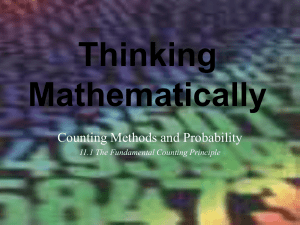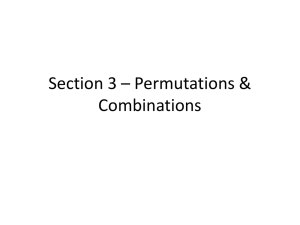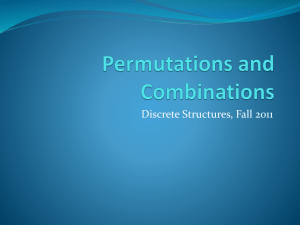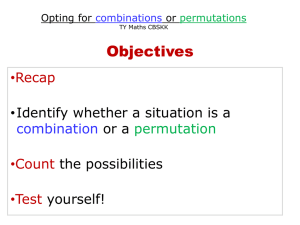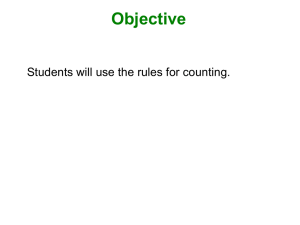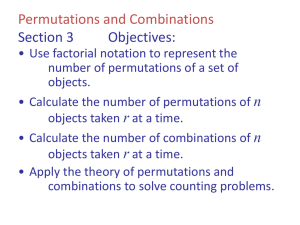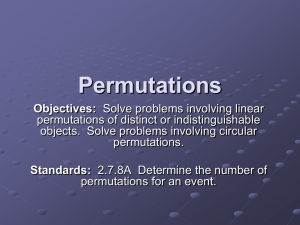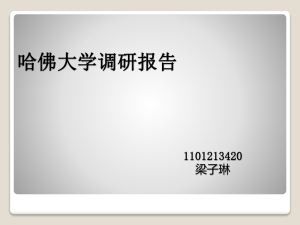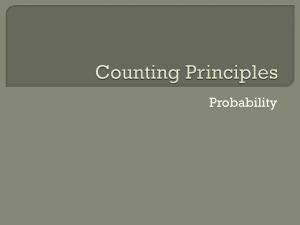Chapter 4 - Dalton State College
advertisement
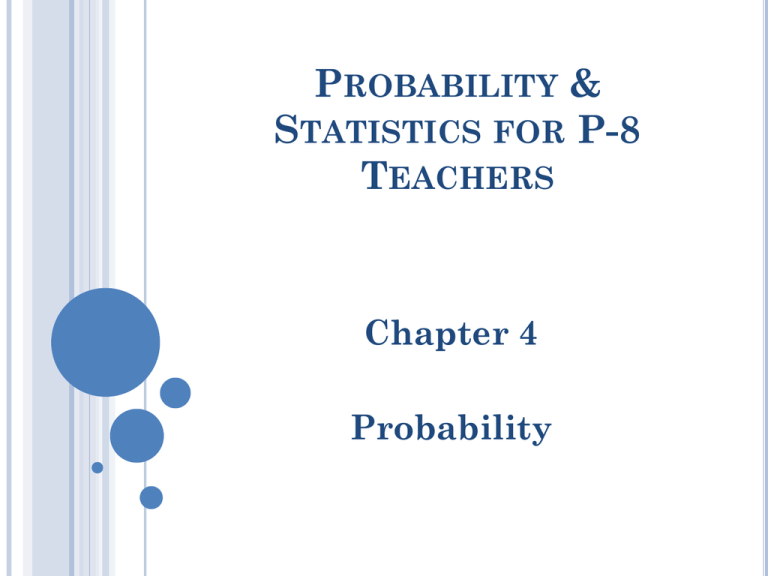
PROBABILITY &
STATISTICS FOR P-8
TEACHERS
Chapter 4
Probability
PROBABILITY
Probability can be defined as the chance of
an event occurring.
It can be used to quantify what the “odds”
are that a specific event will occur.
Some examples of how probability is used
everyday would be weather forecasting, “75%
chance of snow” or for setting insurance rates.
PROBABILITY
Probabilities must be between 0 and 1, inclusive.
A probability of 0 indicates impossibility.
A probability of 1 indicates certainty.
SAMPLE SPACES AND PROBABILITY
A
probability experiment is a chance
process that leads to well-defined results
called outcomes.
An
outcome is the result of a single trial of a
probability experiment.
A
sample space is the set of all possible
outcomes of a probability experiment.
An
event consists of outcomes.
SAMPLE SPACES
Experiment
Toss a coin
Roll a die
Answer a true/false
question
Toss two coins
Sample Space
Head, Tail
1, 2, 3, 4, 5, 6
True, False
HH, HT, TH, TT
SAMPLE SPACES
Find the sample space for rolling two dice.
36 different possible outcomes
SAMPLE SPACES
Find the sample space for the outcomes of
tossing 3 coins
HHH
HHT
HTH
HTT
THH
THT
TTH
TTT
8 different possible outcomes
TREE DIAGRAM
Use a tree diagram to find the sample space for
tossing three coins.
H
H
T
H
T
T
H
HHH
T
HHT
H
HTH
T
HTT
H
THH
T
THT
H
TTH
T
TTT
Notation
P - denotes a probability.
A, B, and C - denote specific
events.
P(A) - denotes the probability of
event A occurring.
SAMPLE SPACES AND PROBABILITY
Probability of an event is the ratio of the outcome of
the event to the sample space
number of ways E can occur
P (E) = number of possible outcomes
PROBABILITY
Determine the probability of getting exactly
two heads when tossing a coin three times
Sample Space
HHH
HHT
HTH
HTT
THH
THT
THT
TTT
3 ways two heads occur
8 possible outcomes
The probability of exactly
two heads is 3/8.
PROBABILITY
If two dice are rolled one time, find the
probability of getting a sum of 7.
P(sum of 7) = 6/36
RELATIONSHIPS AMONG EVENTS
P(A or B) The event “either A or B or both
occur”
P(A & B) The event “both A and B occur”
P(not E) The event “E does not occur”
Union
Intersection
Complement
COMPLEMENT RULE
The complement of event E is the set of
outcomes in the sample space that are not
included in the outcomes of event
P (not E) = 1 – P(E)
FINDING COMPLEMENTS
Find the complement of each event.
Event
Complement of the Event
Rolling a die and getting a 4
Getting a 1, 2, 3, 5, or 6
Selecting a letter of the alphabet
and getting a vowel
Getting a consonant (assume y is a
consonant)
Selecting a month and getting a
month that begins with a J
Getting February, March, April, May,
August, September, October,
November, or December
Selecting a day of the week and
getting a weekday
Getting Saturday or Sunday
COMPLEMENT
Use the complement rule to find the probability
of rolling a dice and getting a number larger
than 1.
P(1) = 1/6
P(>1) = 5/6
Complement Rule
P(>1)= 1 – P(1)
= 1 – 1/6
= 5/6
ADDITION RULE
The rule of addition applies to the following
situation:
We have two events from the same sample
space, and we want to know the probability
that either event occurs.
P (A or B) = P(A) + P(B) – P(A and B)
ADDITION RULE
A card is drawn randomly from a deck of
ordinary playing cards. Find the probability of
picking a heart or an ace.
We know the following:
There are 52 cards in the deck.
There are 13 hearts, so P(H) = 13/52.
There are 4 aces, so P(A) = 4/52.
There is 1 ace that is also a heart, so P(H and A) =
1/52.
Therefore, based on the rule of addition:
P(H or A) = P(H) + P(A) - P(H and A)
P(H or A) = 13/52 + 4/52 - 1/52 = 16/52 = 4/13
MUTUALLY EXCLUSIVE EVENTS
Two
events are mutually exclusive events
if they cannot occur at the same time
no outcomes in common
P(A and B) = 0
MUTUALLY EXCLUSIVE
Determine which events are mutually exclusive
and which are not, when a single die is rolled.
a. Getting an odd number and getting an even number
Getting an odd number: 1, 3, or 5
Getting an even number: 2, 4, or 6
Mutually Exclusive
MUTUALLY EXCLUSIVE
Determine which events are mutually exclusive
and which are not, when a single die is rolled.
b. Getting an odd number and getting a number less
than 4
Getting an odd number: 1, 3, or 5
Getting a number less than 4: 1, 2, or 3
Not Mutually Exclusive
SPECIAL ADDITION RULE
If two events are mutually exclusive then the
addition rule can be simplified since no
intersection occurs:
0
P (A or B) = P(A) + P(B) – P(A and B)
P (A or B) = P(A) + P(B)
BLOOD TYPES
In a sample of 50 people, 21 had type O blood, 22
had type A blood, 5 had type B blood, and 2 had
type AB blood. Set up a frequency distribution
and find the following probabilities.
a. A person has type O blood.
Type Frequency
A
22
B
5
AB
2
O
21
Total 50
f
P O
n
21
50
BLOOD TYPES
In a sample of 50 people, 21 had type O blood, 22
had type A blood, 5 had type B blood, and 2 had
type AB blood. Set up a frequency distribution
and find the following probabilities.
b. A person has type A or type B blood.
Type Frequency
A
B
AB
O
22
5
2
21
Total 50
22 5
P A or B
50 50
27
50
BLOOD TYPES
In a sample of 50 people, 21 had type O blood, 22
had type A blood, 5 had type B blood, and 2 had
type AB blood. Set up a frequency distribution
and find the following probabilities.
c. A person does not have type AB blood.
Type Frequency
A
B
AB
O
22
5
2
21
Total 50
P not AB
1 P AB
2 48 24
1
50 50 25
CONDITIONAL PROBABILITY
Additional
information or other events
occurring may have an impact on the
probability of an event.
Conditional
probability is the
probability that the second event B occurs
given that the first event A has occurred.
CONDITIONAL PROBABILITY
Additional
information may have an
impact on the probability of an event.
Example:
Consider rolling a dice and getting a 6
Sample space is {1, 2, 3, 4, 5, 6}
P(rolling a 6) = 1/6
Suppose we know an even number was
rolled
New sample space is {2, 4, 6}
P(rolling a 6) = 1/3
CONDITIONAL PROBABILITY
Notation:
P(B|A)
represents the probability of event B occurring
after it is assumed that event A has already
occurred. (read P(B|A) as “B given A”)
Conditional Probability
P A and B
P B A
P A
CONDITIONAL PROBABILITY
Consider a standard 52 card deck
Let
A = drawing a card less than five (2, 3, or 4)
B = drawing a spade
Find P(B|A)
Given a card less than five
New sample space (12 cards)
Spade includes 3 cards
P(B|A) = 3/12
CONDITIONAL PROBABILITY
Consider a standard 52 card deck
Let
A = drawing a card less than five (2, 3, or 4)
B = drawing a spade
Find P(B|A) using the formula
P(A) = 12/52
P(A and B) = 3/52
Conditional Probability
P A and B
3/52
P B A
=
= 3/12
12/52
P A
PARKING TICKETS
The probability that Sam parks in a no-parking zone and
gets a parking ticket is 0.06, and the probability that Sam
cannot find a legal parking space and has to park in the
no-parking zone is 0.20. On Tuesday, Sam arrives at
school and has to park in a no-parking zone. Find the
probability that he will get a parking ticket.
N= parking in a no-parking zone, T= getting a
ticket
P N and T 0.06
0.30
P T N
0.20
P N
WOMEN IN THE MILITARY
A recent survey asked 100 people if they thought
women in the armed forces should be permitted
to participate in combat. The results of the
survey are shown.
WOMEN IN THE MILITARY
Find the probability that the respondent answered
yes (Y), given that the respondent was a female
(F).
P F and Y
P Y F
P F
8
8
100
50
50
100
4
25
MULTIPLICATION RULE
We can create a multiplication rule for the
intersection of two events A and B by
rewriting the conditional probability
formula
P(A and B)
P(B|A) =
P(A)
Solving for the intersection yields:
P(A and B) = P(A) P(B|A)
or
P(A and B) = P(B) P(A|B)
MULTIPLICATION RULE
From the bag of marbles, find the probability of
picking two red marbles from a bag with 4 red and
3 blue marbles.
Pick a red marble from the first
draw is 4/7
Since a red has already been
drawn, then 3 red marbles are left
from the remaining 6 marbles
P(red and red) = P(red) P(red|red)
= (4/7)
(3/6)
=
6/21
MULTIPLICATION RULE
At a university in western Pennsylvania, there
were 5 burglaries reported in 2003, 16 in 2004,
and 32 in 2005. If a researcher wishes to select
at random two burglaries to further investigate,
find the probability that both will have occurred
in 2004.
Dependent Events
P C1 and C2 P C1 P C2 C1
16 15
60
53 52 689
INDEPENDENCE
Two events A and B are independent
events if the fact that A occurs does not
affect the probability of B occurring.
Examples:
Tossing a coin and rolling a die
Choosing a 3 from a deck of cards,
replacing it, and then choosing an ace as
the second card
INDEPENDENCE
If two events are independent, then the
events do not affect the probability outcomes
One way to represent this is by:
P(B|A) = P(B)
since event A has no affect on event B
regardless of whether A was given to us or
not
SPECIAL MULTIPLICATION RULE
If two events are independent then the
multiplication rule can be simplified since the
conditional probability has no affect on the
initial probability
P(B)
P (A and B) = P(A) P(B|A)
P (A and B) = P(A) P(B)
INDEPENDENT EVENTS
A coin is flipped and a die is rolled. Find the
probability of getting a head on the coin and a 4
on the die.
Independent Events
P Head and 4 P Head P 4
1 1
1
2 6 12
This problem could be solved using sample
space.
H1, H2, H3, H4, H5, H6, T1, T2, T3, T4, T5, T6
INDEPENDENT EVENTS
A Harris poll found that 46% of Americans say
they suffer great stress at least once a week. If
three people are selected at random, find the
probability that all three will say that they
suffer great stress at least once a week.
Independent Events
P S and S and S P S P S P S
0.46 0.46 0.46
0.097
INDEPENDENT EVENTS
Determine if the following events, based on a
standard deck of cards, are independent of each
other
A = Drawing an ace
B = Drawing a heart
Show
P(B|A) = P(B)
P(B) = 13/52 = 1/4
P(B|A) = 1/4
Since P(B|A) = P(B) = 1/4
then the events are independent
BASIC COUNTING PRINCIPLES
Counting problems are of the
following kind:
“How many different 8-letter
passwords are there?”
“How many possible ways are there to
pick 11 soccer players out of a 20player team?”
“What is the probability of winning the
lottery?”
FUNDAMENTAL COUNTING RULE
Stan is about to order dinner at a restaurant.
He has a choice of:
• two appetizers (soup or salad)
• three main courses (pasta, steak, or fish)
• two desserts (cake or pie)
How many different meal combinations can
Stan choose?
Using a Tree Diagram to Determine the Number of
Combinations
Appetizers
Main Courses
pasta
soup
steak
fish
pasta
salad
steak
fish
Desserts
cake
pie
cake
pie
cake
pie
12
Combinations
cake
pie
cake
pie
cake
pie
COUNTING RULES
The fundamental counting rule is also
called the multiplication of choices.
If a task is made up of many stages, the
total number of possibilities for the task is
given by
m×n×p× ...
where m is the number of choices for the
first stage, and n is the number of choices
for the second stage, p is the number of
choices for the third stage, and so on.
FUNDAMENTAL COUNTING RULE
A paint manufacturer wishes to manufacture several
different paints. The categories include
Color: red, blue, white, black, green, brown, yellow
Type: latex, oil
Texture: flat, semigloss, high gloss
Use: outdoor, indoor
How many different kinds of paint can be made if you
can select one color, one type, one texture, and one use?
# of × # of × # of
× # of
Colors
Types Textures
Uses
7
×
2
×
3
84 different kinds of paint
×
2
= 84
FUNDAMENTAL COUNTING RULE
Colleen has six blouses, four skirts and four
sweaters.
How many different outfits can she choose from,
assuming she wears three different items at once?
Blouses Skirts Sweaters
= 96 outfits
6 × 4 × 4
The final score in a soccer game is 5 to 4 for Team A.
How many different half-time scores are possible?
Team A Team B
(0 - 4)
(0 - 5)
6
×
5
= 30 different possible
half-time scores.
FUNDAMENTAL COUNTING RULE
How many four-letter arrangements are possible?
use any
of the 26
letters:
A-Z
26 × 26 × 26 × 26
1st
2nd
3rd
4th
= 456,976
How many four-letter arrangements are possible if
a letter cannot be repeated?
use any
of the 26
letters:
A-Z
26 × 25 × 24 × 23
1st
2nd
3rd
4th
only 25 only 24 only 23
letters letters letters
left
left
left
= 358,800
PERMUTATIONS
A permutation is an arrangement of a set of objects
for which the order of the objects is important.
Show the number of ways of arranging the letters of
the word CAT:
CAT
CTA
ACT
ATC
TCA
TAC
There are six arrangements or
permutations of the word CAT.
By changing the order of the
letters, you have a different
permutation.
Using the Fundamental Counting Principle, we
would have 3 x 2 x 1 number of distinct
arrangements or permutations.
FACTORIAL NOTATION
In calculating permutations, we often encounter
expressions such as 3 x 2 x 1. The product of
consecutive natural numbers in decreasing order down
to the number one can be represented using factorial
notation:
Factorial
is the product of all the positive
numbers from 1 to a number.
n ! n n 1 n 2 3 2 1
0! 1
3 x 2 x 1 = 3! This is read as “three factorial”.
FACTORIAL NOTATION
4!
= 4 × 3 × 2 × 1 = 24
10! = 10 × 9 × 8 × 7 × 6 × 5 × 4 × 3 × 2 × 1
= 3,628,800
10! 10 9 8 7 .... 3 2 1
7!
7 6 5 ... 3 2 1
10 9 8
= 720
PERMUTATIONS
Permutation
is an arrangement of objects
in a specific order. Order matters.
n!
n n 1 n 2 n r 1
n Pr
n r !
r items
In general, if we have n objects but only want to
select r objects at a time
PERMUTATIONS
Suppose a business owner has a choice of 5 locations in
which to establish her business. She decides to rank
each location according to certain criteria, such as price
of the store and parking facilities. How many different
ways can she rank the 5 locations?
first second third fourth fifth
choice choice choice choice choice
5
4 3 2 1
120 different ways to rank the locations
Using factorials, 5! = 120.
Using permutations, 5P5 = 120.
PERMUTATIONS
Suppose the business owner wishes to rank only the
top 3 of the 5 locations. How many different ways can
she rank them?
first second third
choice choice choice
5 4 3
60 different ways to rank the locations
Using permutations, 5P3 = 60.
PERMUTATIONS
How many three-letter permutations can be formed
from the letters of the word DINOSAUR?
the number of permutations of eight objects
taken three at a time.
This may be written as 8P3.
8!
=
8P3 =
(8–3)!
8!
=
5!
8×7×6×5×4×3×2×1
= 336
5×4×3×2×1
PERMUTATIONS
Find the following permutations
6!
= 6 × 5 = 30
6P2 =
4!
7P4 =
7!
= 7 × 6 × 5 × 4 = 840
3!
3!
=3×2×1=6
3P3 =
0!
Note:
nPn =
n!
PERMUTATIONS
A school musical director can select 2 musical plays to
present next year. One will be presented in the fall,
and one will be presented in the spring. If she has 9 to
pick from, how many different possibilities are there?
Order matters, so we will use permutations.
9!
72
9 P2
7!
or
P 9 8 72
9 2
2
PERMUTATIONS WITH REPETITION
How many four-letter words can be made using
the letters of PEER?
4P4
= 4!
Note that PEER and PEER are not distinguishable,
therefore, they count as one permutation.
When this happens, you must divide by the factorial of
the number of repeated terms.
For PEER, the number of arrangements is:
“E”
occurs
twice
4!
= 4 × 3 = 12
=
2!
2!
4P4
COUNTING RULES
Consider selecting two people out
of three individuals (A, B, C) for
President and Vice-President of a
committee
3P2
=6
AB
BA
AC
CA
BC
CB
Now consider selecting two people
out of three individuals (A, B, C) for
AB
committee membership
Here choice A,B is the same
committee as choice B,A
AC
BC
6
choices
3
choices
COMBINATIONS
Combination is a grouping of objects.
Order does not matter.
n!
n Cr
n r !r !
Pr
r!
n
When order matters, you have permutations.
When order does not matter, you have combinations
COMBINATIONS
A committee of four students is to be
selected from a group of ten students. In
how many ways can this be done?
10C4
10!
(10 4)! 4!
= 210
The committee of four can be
selected in 210 ways.
COMBINATIONS
A newspaper editor has received 8 books to review. He
decides that he can use 3 reviews in his newspaper.
How many different ways can these 3 reviews be
selected?
The placement in the newspaper is not mentioned, so
order does not matter. We will use combinations.
8!
8!/ 5!3! 56
8 C3
5!3!
P3
or 8C3
56
3!
8
COMBINATIONS
A company is hiring people to fill five identical positions.
There are 12 applicants. How many ways can the five
positions be filled?
12C5
12!
(12 5)! 5!
The company can fill the five
positions 792 ways.
= 792
The company wants to hire Applicant A and any four of
the others. How many ways can the five positions be
filled now?
1!
11!
With Applicant A,
1C1 x 11C4
1!0! 7!4! there are 330 ways to
= 330
fill the position
COMBINATIONS
There are seven books to choose from.
How many ways can five or more books be
selected?
Select 5 or 6 or 7:
7C5
+ 7C6 + 7C7 = 21 + 7 + 1
= 29
There are 29
ways to select 5
or more books.
COMBINATIONS
In a club there are 7 women and 5 men. A committee of
3 women and 2 men is to be chosen. How many
different possibilities are there?
There are not separate roles listed for each committee
member, so order does not matter. We will use
combinations.
7!
5!
Women: 7C3
35, Men: 5C2
10
4!3!
3!2!
There are 35·10=350 different possibilities.
COMBINATIONS
How many five-card hands can be dealt from
a standard deck of 52 cards if:
a) each hand must contain two aces?
4C2 x 48C3 =
103 776
b) each hand must contain three red cards?
26C3 x 26C2 =
845 000
PROBABILITY AND COUNTING RULES
The counting rules can be combined with the
probability rules in this chapter to solve
many types of probability problems.
By using the fundamental counting rule, the
permutation rules, and the combination rule,
you can compute the probability of outcomes of
many experiments, such as getting a full house
when 5 cards are dealt or selecting a committee
of 3 women and 2 men from a club consisting of
10 women and 10 men.
PLAYING CARDS
Two cards are picked at random from a deck of playing cards.
What is the probability that they are both kings?
Method 1: Using the fundamental counting principle
1
4
3
P(2 kings) =
221
52 51
Method 2: Using combinations
Number of ways of choosing 2 kings from 4 kings is 4C2.
Number of ways of choosing 2 cards from 52 cards is 52C2.
C2
P(2 kings) =
52 C 2
4
4!
(4 2)!2!
52!
(52 2)!2!
1
221
MAGAZINE SELECTION
A store has 6 TV Graphic magazines and 8 Newstime
magazines on the counter. If two customers purchased
a magazine, find the probability that one of each
magazine was purchased.
TV Graphic: One magazine of the 6 magazines
Newstime: One magazine of the 8 magazines
Total: Two magazines of the 14 magazines
6
C1 8 C1 6 8 48
91
91
14 C2
COMBINATION LOCKS
A combination lock consists of 50 numbers (1 through
50). If a 3-number combination is needed, find the
probability that the combination is the number 1-2-3 in
that order. The same number can be used more than
once. (Note: A combination lock is really a permutation
lock.)
There are 50·50·50 = 125,000 possible combinations.
The number 1-2-3 is one combination.
P(1-2-3) = 1/125,000
